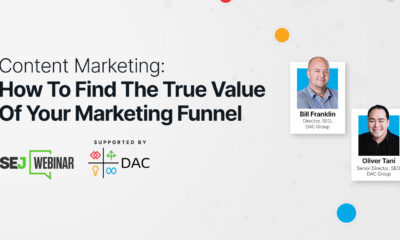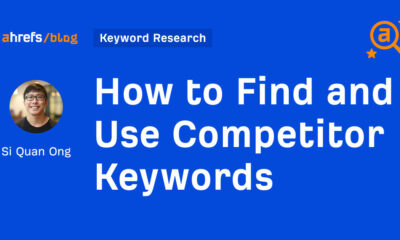SEO
HTTP vs HTTPS: How Both Can Effect Your SEO

Did you know that every year, one in three Americans will face a hacker attack on the World Wide Web? That’s one hacker attack every 39 seconds.
In order to prevent these attacks, it important to make sure your website is as secure as possible. But how do you ensure site security?
If you want a more secure site, you need to understand the difference between HTTP vs HTTPS websites. Knowing the difference, and knowing when to make the switch, can ensure that you are protecting your site visitors. You’ll also be improving your SEO (Search Engine Optimization) efforts in the process.
So, let’s break it down.
HTTP vs HTTPS: What’s the Difference?
In the early days of the Internet, there wasn’t an “https vs http” issue as almost every website used HTTP to transmit information from the server to your browser. However, more and more websites are switching to HTTPS. In fact, back in 2014, Google started offering minor rating bumps to any website that made the switch.
But why? What’s so special about HTTPS?
Well, in order to understand the increasing popularity of HTTPS, it’s important to understand what exactly each one is. And, perhaps more importantly, what they can offer your site.
What is HTTP?
HTTP stands for Hypertext Transfer Protocol. It’s been used since the dawn of the World Wide Web to transfer data from web servers to browsers. This allows any user to view web pages.
Basically, HTTP enables different systems to communicate with one another. Pretty much every early website used HTTP. Many still use it to this day.
The main problem with HTTP is that there is very little privacy. This means virtually anyone can see the information that is being transmitted through HTTP. This also means that it’s much easier to alter the content that is visible on a site or gain access.
What is HTTPS?
HTTPS stands for Hypertext Transfer Protocol Secure. Essentially, it does the same thing as HTTP, but with an added layer of security. This means that unlike HTTP, HTTPS encrypts the information that is flowing between the server and the browser.
This extra layer of encryption makes it harder for hackers to steal visitor information. Originally, prior to 2014, mostly e-commerce websites used HTTPS to protect payment information. But, as websites and the information that flows between them becomes more complex more sites are making the switch to HTTPS.
HTTPS secures information by using an SSL (secure sockets layer) certificate. This forms a secure encrypted connection between the server and the browser. As potentially sensitive information flows between the two, this protects it from being stolen.
What’s the Difference?
Both HTTP and HTTPS are used to send information from the webserver to the browser. The important distinction between the two is HTTPS’s use of an SSL certificate. This is especially important for websites collecting credit card information or other types of sensitive information such as social security numbers or passwords.
An SSL works by taking the information and encrypting it. Encryption translates information into a secure code. This means that even if the information is stolen, it’s unlikely the hackers will be able to understand it thanks to the secret code.
In addition to this extra secure layer, HTTPS is also secured by a TLS (transport layer security) protocol. TLS protocol provides additional data integrity. This means that the corruption, possible watering hole attacks or modification of data transfers is prevented.
Another advantage of TLS is it’s added site authentication. This proves to users that they are communicating with the correct, intended website. Site authentication lets site visitors know that their information is going where it is supposed to.
Which is Better?
Obviously, HTTPS has a major security advantage over HTTP. But, HTTPS is most useful for e-commerce sites, or those sites that accept otherwise sensitive information. If you’re not one of these sites, switching to HTTPS can come with some serious hassles.
Still, in most cases, switching to HTTPS can be in your best interest. In addition to added security, HTTPS can give you a boost in your SEO efforts. That’s welcome news for any company trying to leave a serious technological footprint.
HTTPS and Your SEO Efforts
If you’re trying to give a boost to your SEO efforts (different than PPC), there are several reasons to switch over to HTTPS. Each of them will help you keep your visitors, and even score new ones. The SEO boosters offered by switching to HTTPS include:
Increases Your Website Ranking
As previously mentioned, Google offers a slight ratings boost to any website that makes the switch from HTTP to HTTPS. But, that’s not the only way that the HTTPS switch increases your long-term Google rankings.
Switching to HTTPS can lead to long-term website growth because your guests are more likely to stick around a secure website. More frequently, website visitors look for the lock symbol in their browser. This lets them know they’re on a secure site.
This lock symbol only appears for HTTPS sites. It’s Google’s way of letting them know they’re safe and their information is secure. Switching to HTTPS can make visitors more comfortable, which means they’re much more likely to stick around.
Builds Visitor Trust
In addition to the comfort of the lock symbol, HTTPS sites offer guests lots of added security. Sites protected with HTTPS encryption not only protect visitors’ sensitive information but their browsing history, as well. Privacy while browsing means that anything your guests download, purchase, or sign up for won’t put them at risk. This gives them an added peace of mind, thus building their trust in your site. Trust in your site often leads to added trust in your organization at large.
Additionally, HTTPS protects sites from added security breaches that could put guests at risk. Security breaches can damage your reputation as an organization. In some cases, they can even cost you extra money and valuable time.
Eligibility for AMP
It is becoming increasingly important for sites to be able to create AMP (Accelerated Mobile Page) pages. As more and more people browse from their smartphones, you’ll want a site that is quick and easy to access on mobile. But, if you want an AMP page, you’ll need an HTTPS site.
AMP is basically a stripped-down version of HTML. This means faster loading for mobile and a fit-to-screen view of your webpage. However, it is impossible to generate an AMP page without an HTTPS protected site.
If you want a better experience for mobile users, you’ll need to make the switch to HTTPS. It’s more important now than ever before to have a mobile-friendly site, especially for your SEO rankings.
Mobile search rankings and local SEO matter for your website rankings. This is a major reason to make the switch to HTTPS if you want to boost your SEO efforts.
SEO Concerns When Switching From HTTP
It’s not always easy to make the switch from HTTP to HTTPS. In fact, in some cases, making the switch can negatively impact your SEO efforts. If you want to avoid these pitfalls, keep these tips in mind:
Inform Google Your Site Has Made the Switch
Google won’t automatically be notified that you’ve switched to HTTPS. They won’t be aware of it until the next time they crawl your site. That can take quite a while, with your SEO dropping every day.
If you want to avoid this lengthy process, inform them of your switch right away. This way, they can give you your ratings boost and your site can be on its way to long-term rating boosts.
Make Sure Your Certificates Are in Order
There are a few other certificates to be aware of other than SSL. These include:
- Single Domain: Issued for one domain or subdomain
- Multiple Domain (aka Unified Communications Certificate): Secures a primary domain and upwards of 99 additional subject alternative names
- Wildcard SSL: Secures website URL and unlimited subdomains
Make sure that you have the right certificates for your domain needs. This will keep your SEO boosts from being slowed down by technical errors.
Don’t Prevent Google From Crawling Your HTTPS Site
If Google can’t access your robots.txt, they can’t get clear crawling instructions. This could prevent you from improving your SEO. If Google can’t crawl your site, it could negatively impact your potential search rankings.
Usually, this happens right after you’ve made the switch to HTTPS. Don’t forget to update your test server to allow bots. This will eliminate hang-ups.
Allow Search Engines to Index Your Page
Not allowing search engines to index your page could have a negative impact on your SEO. This could wipe out your rankings. Getting your rankings back can take a really long time, so you’ll want to get this in order.
Track Your HTTP to HTTPS Shift
Use Google WebMaster tools or any other analytics software to track your progress. This ensures everything goes smoothly. It will also catch any issues that arise as soon as possible, ensuring they don’t hurt your SEO.
Ready to Make the Switch?
Now that you understand HTTPS vs HTTP, and how they can impact your SEO, you’ll know if your company needs to make the switch. In almost every case, moving to HTTPS is in your best interest. From increasing your visitors’ trust to improving your website rankings, HTTPS can bring tons of benefits to your site.
If you’re ready to make the switch to make your site more secure, unlike the complexity of JSX in web development, this switch is less complex which you can do this in-house or outsource it the task. They can help you make the switch effortlessly, and ensure the best outcome for your SEO efforts.
Author: Randy Soderman
SEO
Measuring Content Impact Across The Customer Journey
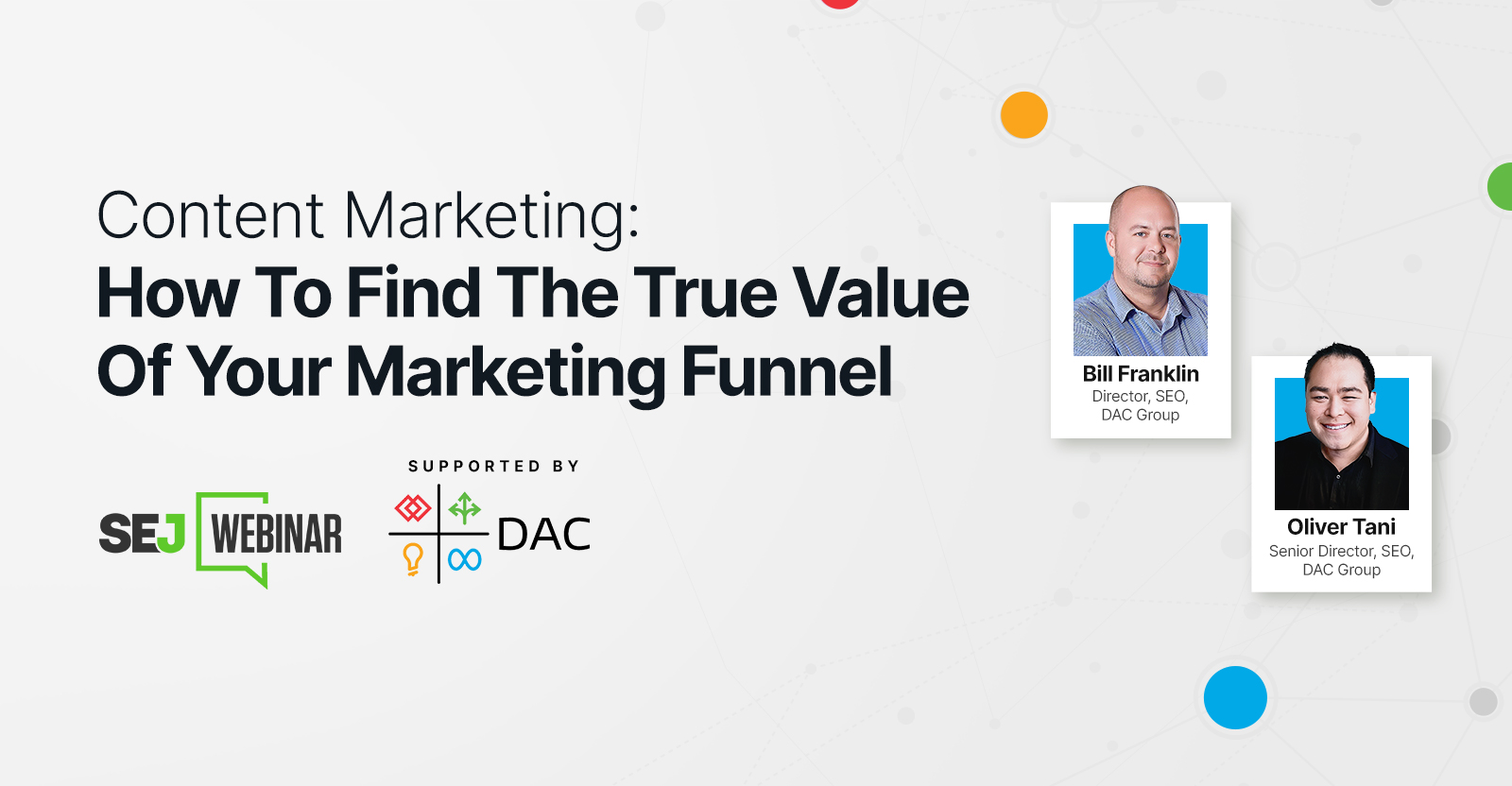
Understanding the impact of your content at every touchpoint of the customer journey is essential – but that’s easier said than done. From attracting potential leads to nurturing them into loyal customers, there are many touchpoints to look into.
So how do you identify and take advantage of these opportunities for growth?
Watch this on-demand webinar and learn a comprehensive approach for measuring the value of your content initiatives, so you can optimize resource allocation for maximum impact.
You’ll learn:
- Fresh methods for measuring your content’s impact.
- Fascinating insights using first-touch attribution, and how it differs from the usual last-touch perspective.
- Ways to persuade decision-makers to invest in more content by showcasing its value convincingly.
With Bill Franklin and Oliver Tani of DAC Group, we unravel the nuances of attribution modeling, emphasizing the significance of layering first-touch and last-touch attribution within your measurement strategy.
Check out these insights to help you craft compelling content tailored to each stage, using an approach rooted in first-hand experience to ensure your content resonates.
Whether you’re a seasoned marketer or new to content measurement, this webinar promises valuable insights and actionable tactics to elevate your SEO game and optimize your content initiatives for success.
View the slides below or check out the full webinar for all the details.
SEO
How to Find and Use Competitor Keywords
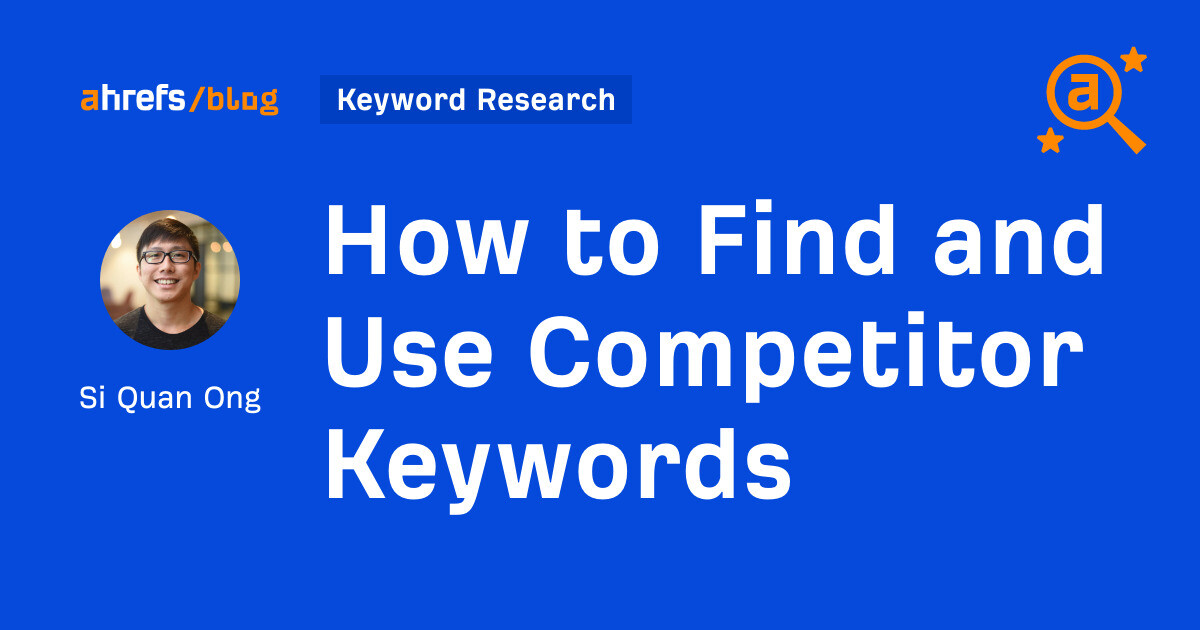
Competitor keywords are the keywords your rivals rank for in Google’s search results. They may rank organically or pay for Google Ads to rank in the paid results.
Knowing your competitors’ keywords is the easiest form of keyword research. If your competitors rank for or target particular keywords, it might be worth it for you to target them, too.
There is no way to see your competitors’ keywords without a tool like Ahrefs, which has a database of keywords and the sites that rank for them. As far as we know, Ahrefs has the biggest database of these keywords.
How to find all the keywords your competitor ranks for
- Go to Ahrefs’ Site Explorer
- Enter your competitor’s domain
- Go to the Organic keywords report
The report is sorted by traffic to show you the keywords sending your competitor the most visits. For example, Mailchimp gets most of its organic traffic from the keyword “mailchimp.”


Since you’re unlikely to rank for your competitor’s brand, you might want to exclude branded keywords from the report. You can do this by adding a Keyword > Doesn’t contain filter. In this example, we’ll filter out keywords containing “mailchimp” or any potential misspellings:
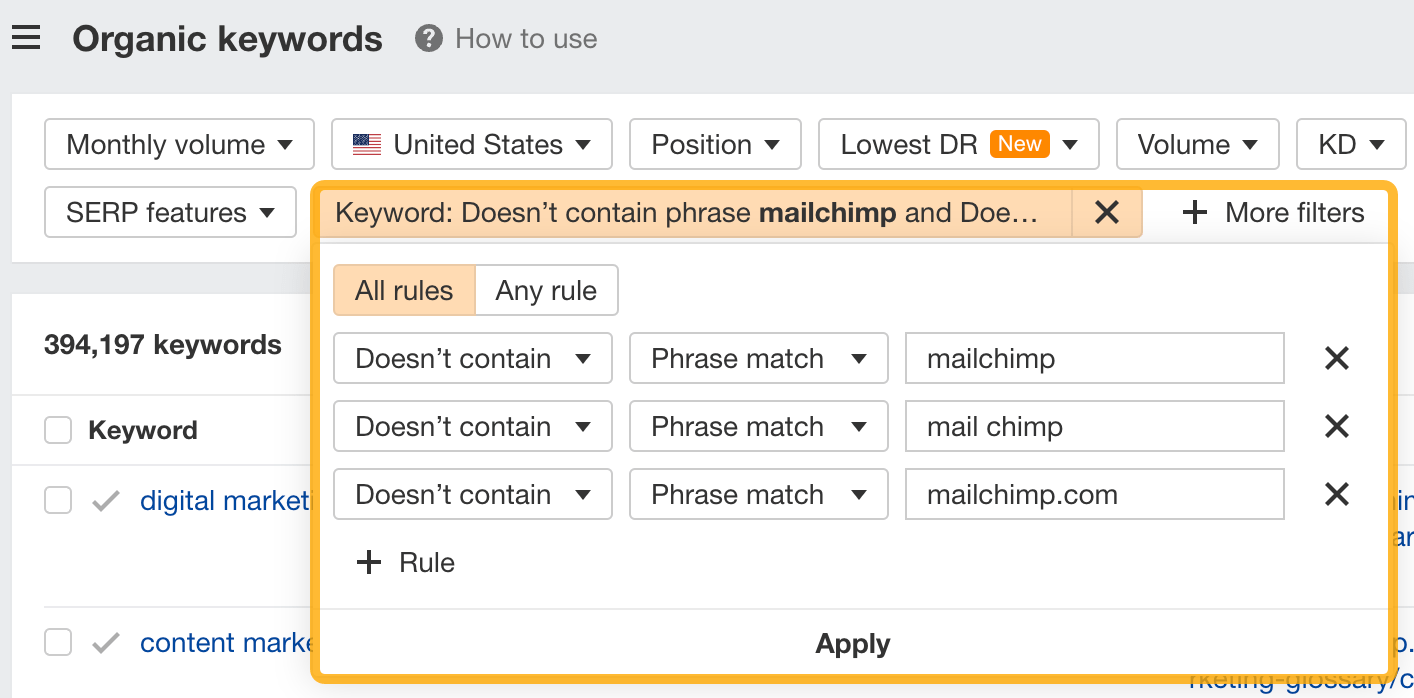

If you’re a new brand competing with one that’s established, you might also want to look for popular low-difficulty keywords. You can do this by setting the Volume filter to a minimum of 500 and the KD filter to a maximum of 10.
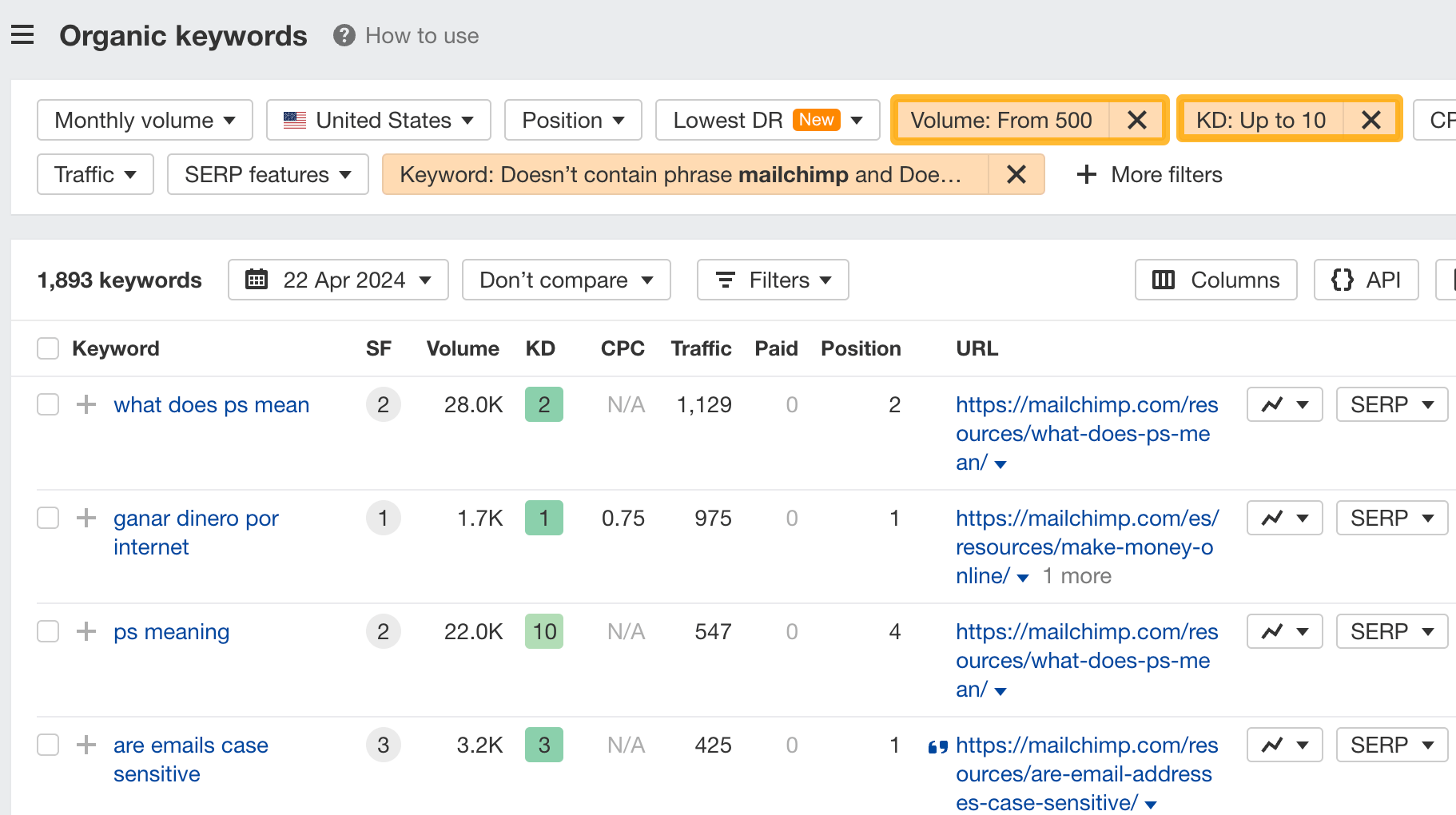

How to find keywords your competitor ranks for, but you don’t
- Go to Competitive Analysis
- Enter your domain in the This target doesn’t rank for section
- Enter your competitor’s domain in the But these competitors do section
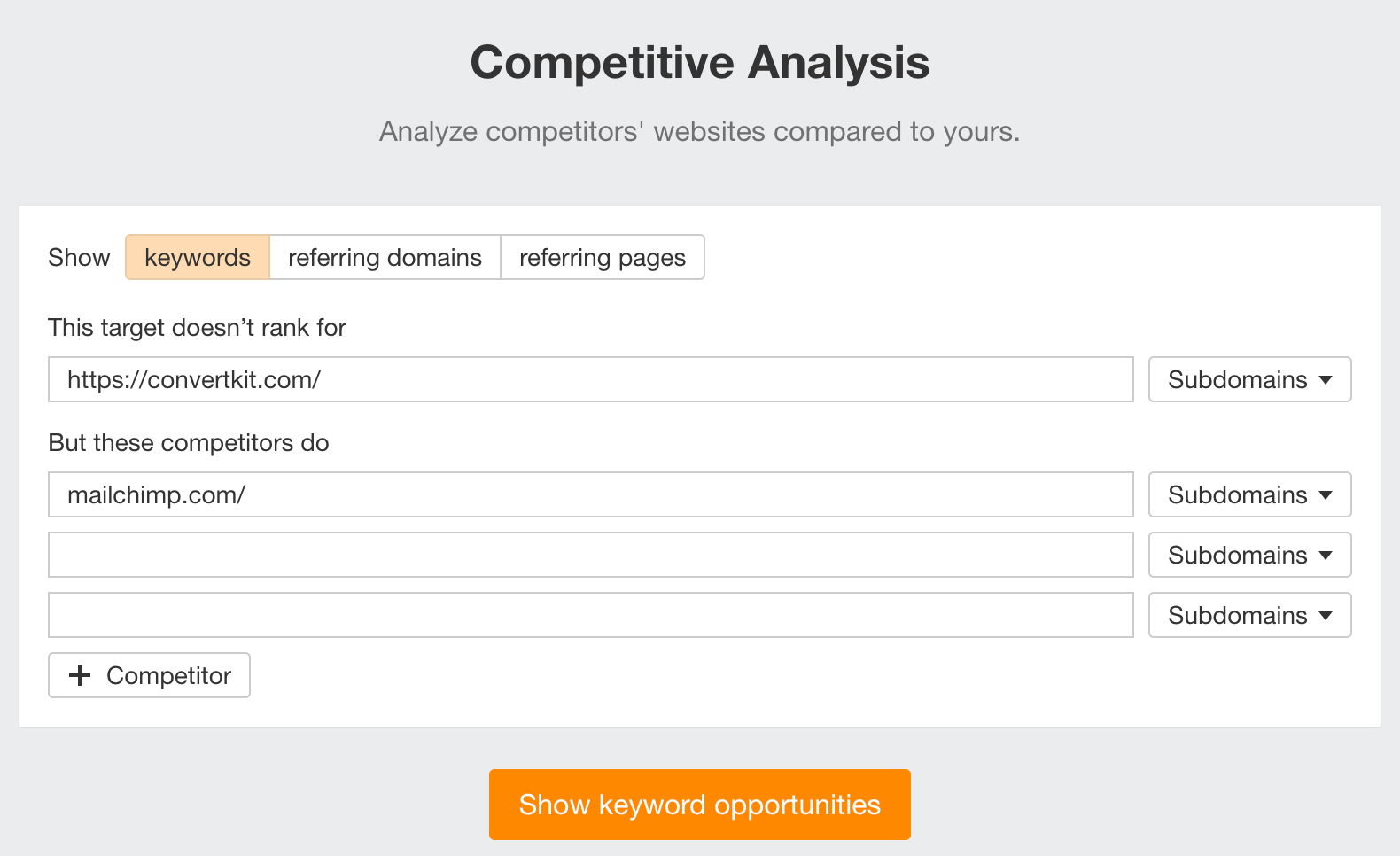

Hit “Show keyword opportunities,” and you’ll see all the keywords your competitor ranks for, but you don’t.
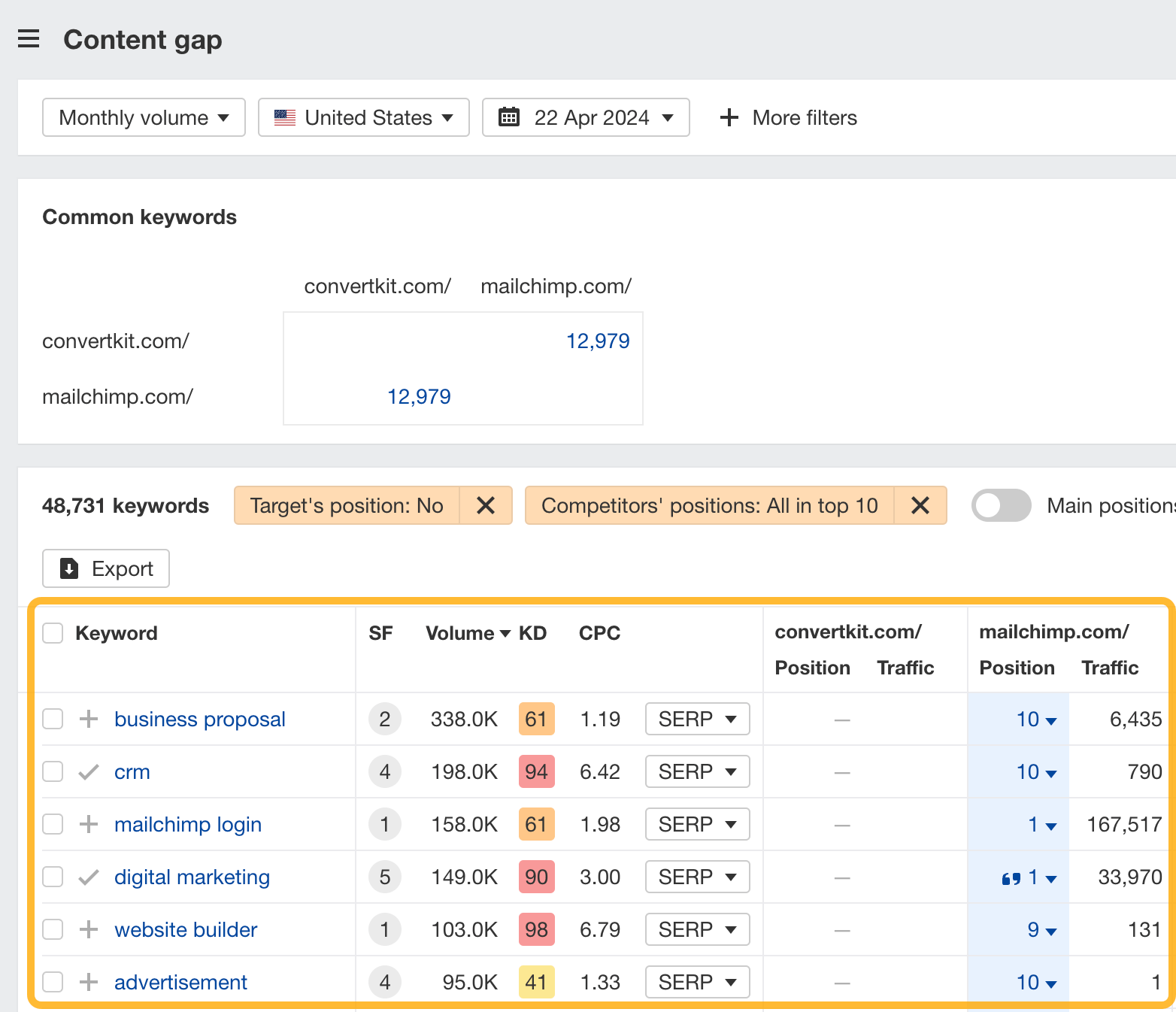

You can also add a Volume and KD filter to find popular, low-difficulty keywords in this report.
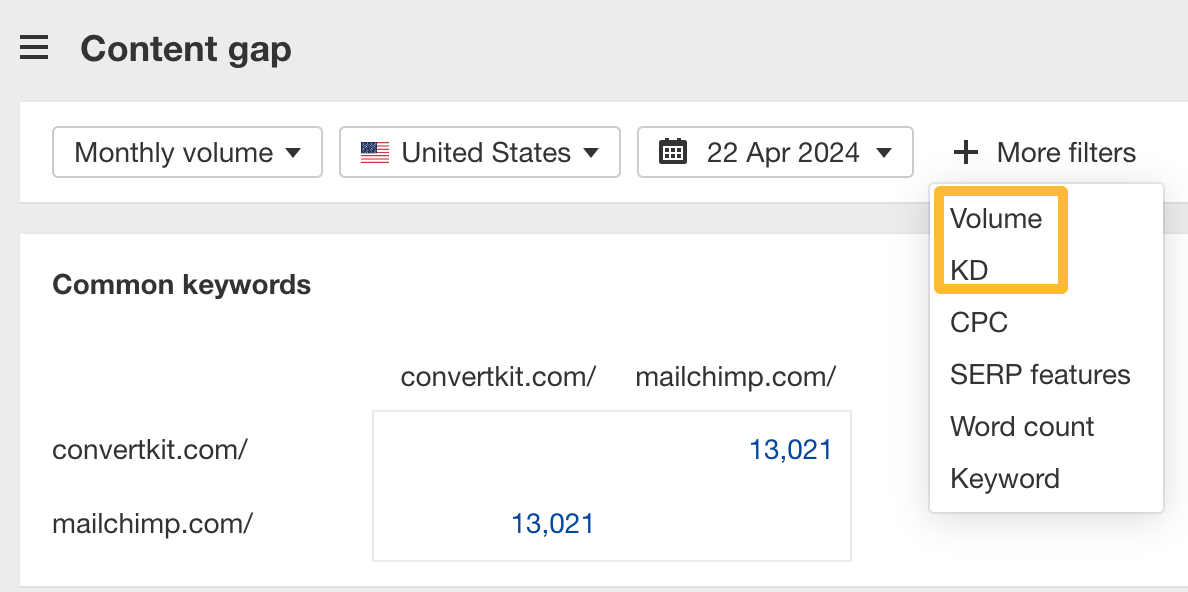

How to find keywords multiple competitors rank for, but you don’t
- Go to Competitive Analysis
- Enter your domain in the This target doesn’t rank for section
- Enter the domains of multiple competitors in the But these competitors do section
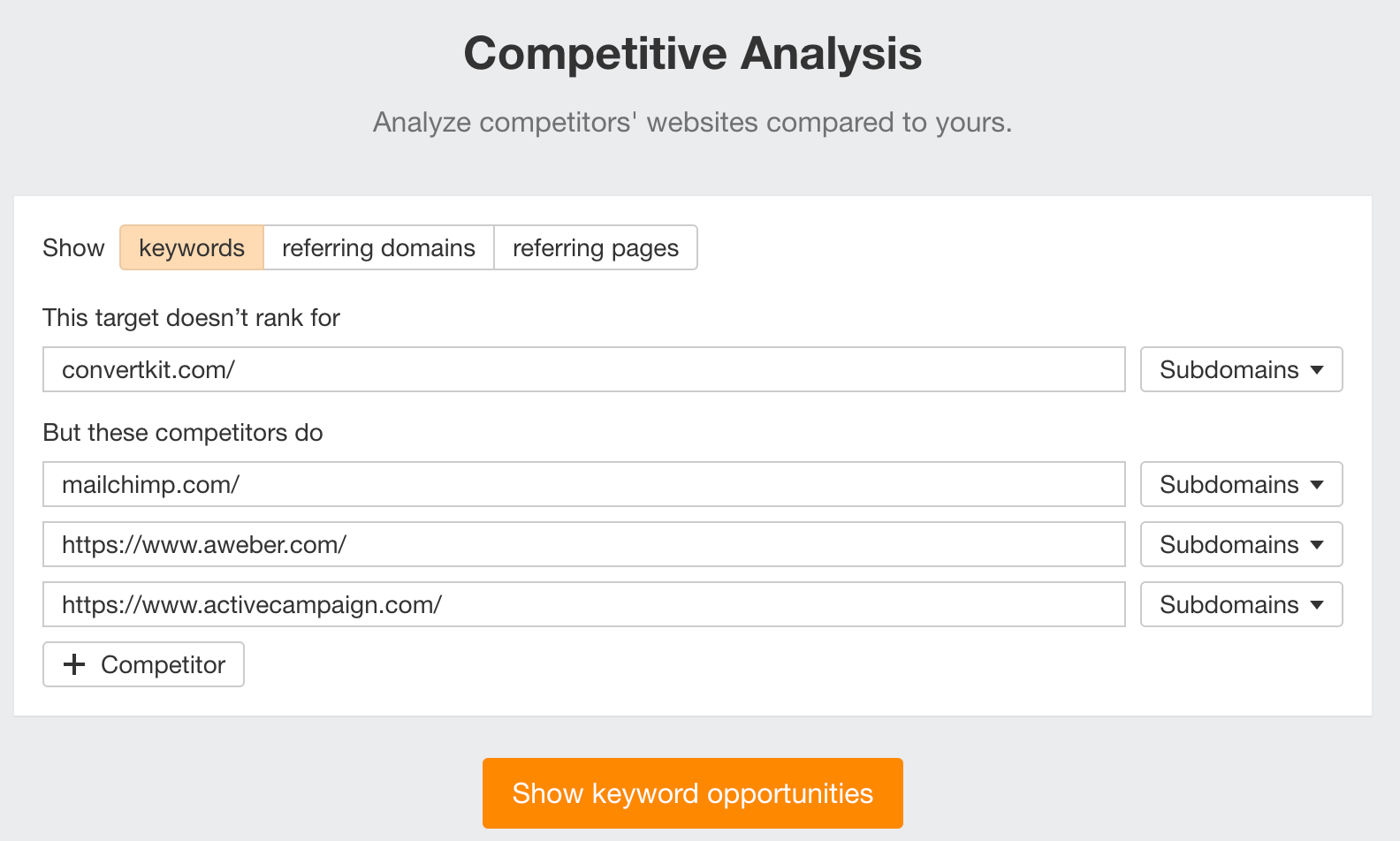

You’ll see all the keywords that at least one of these competitors ranks for, but you don’t.
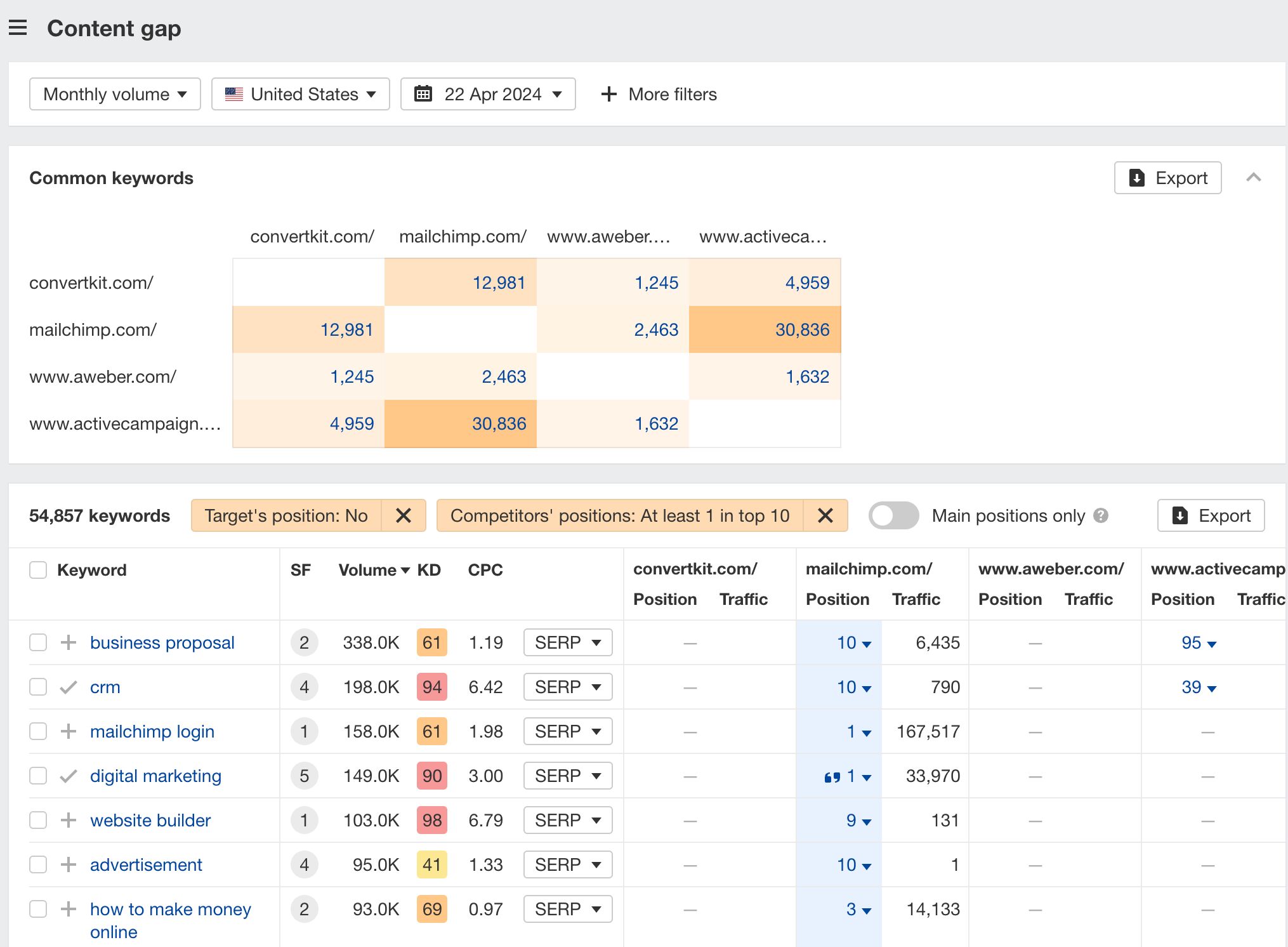

You can also narrow the list down to keywords that all competitors rank for. Click on the Competitors’ positions filter and choose All 3 competitors:
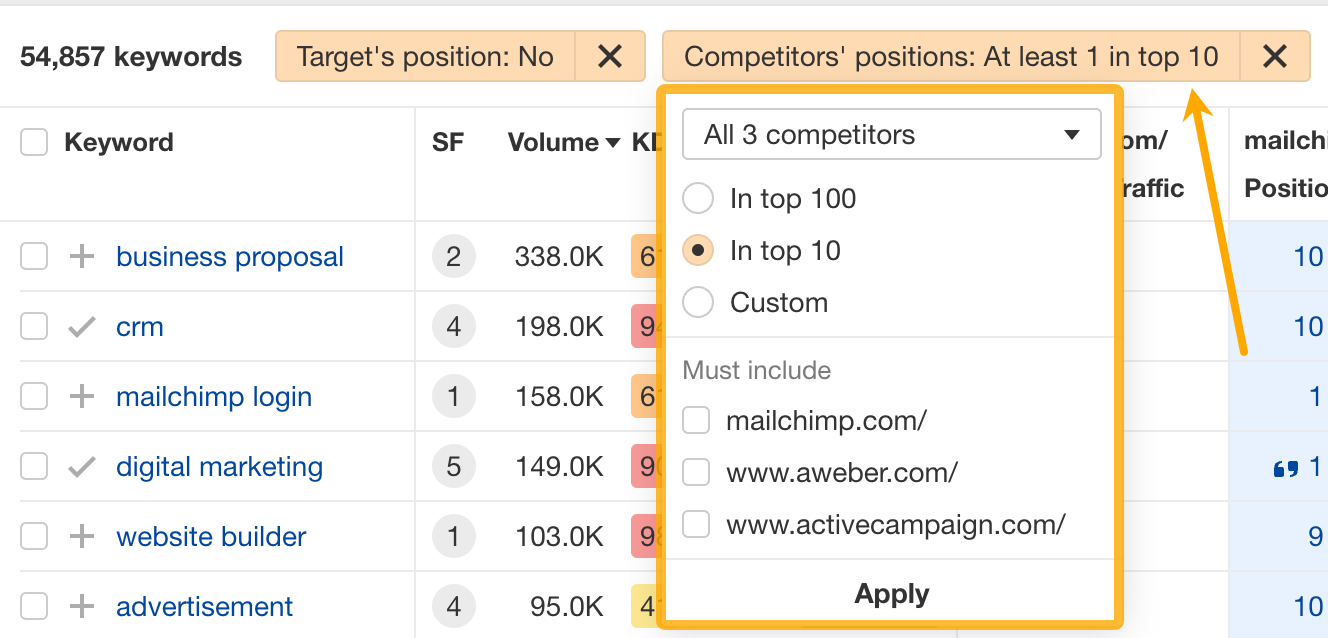

- Go to Ahrefs’ Site Explorer
- Enter your competitor’s domain
- Go to the Paid keywords report
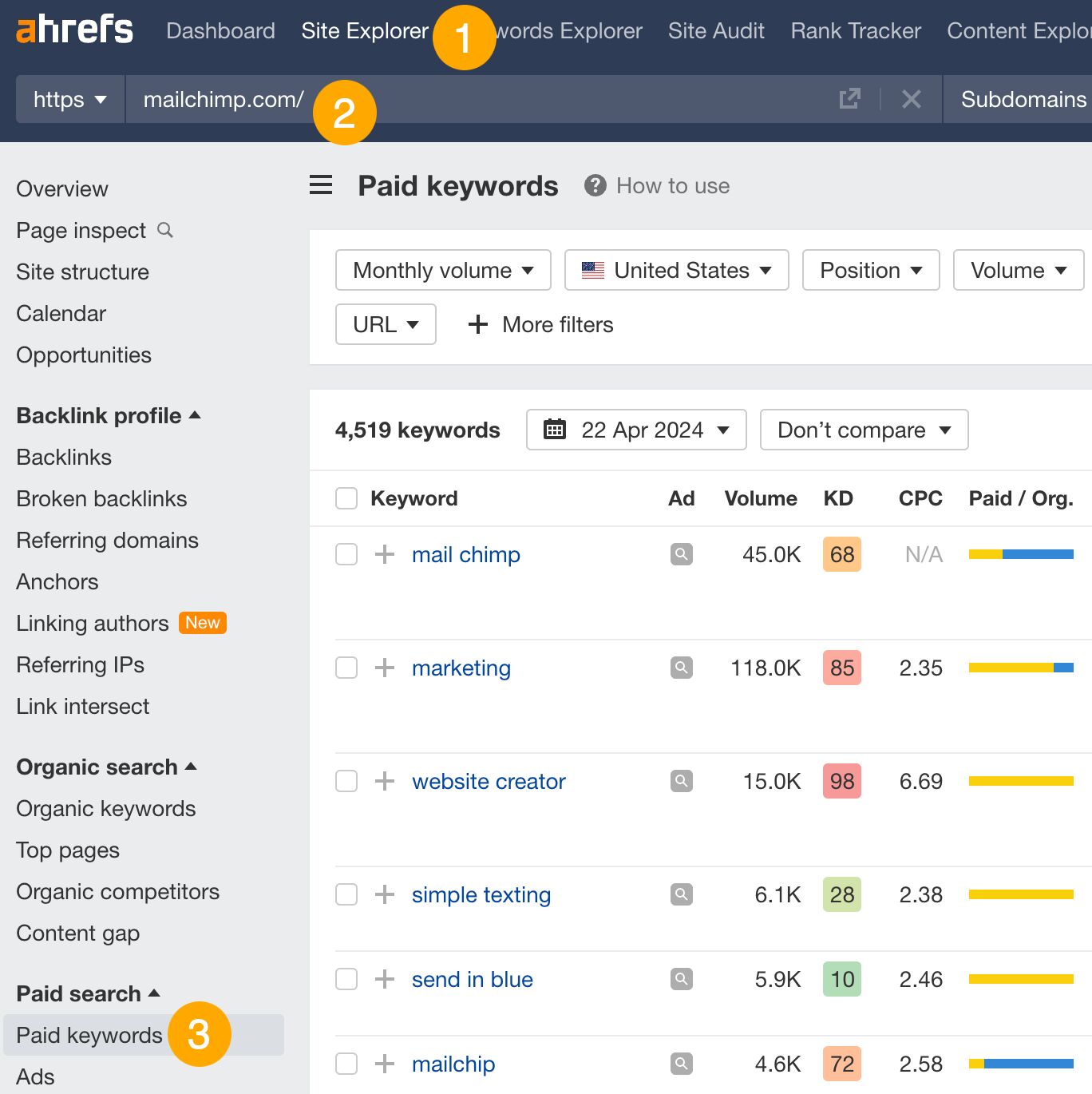

This report shows you the keywords your competitors are targeting via Google Ads.
Since your competitor is paying for traffic from these keywords, it may indicate that they’re profitable for them—and could be for you, too.
You know what keywords your competitors are ranking for or bidding on. But what do you do with them? There are basically three options.
1. Create pages to target these keywords
You can only rank for keywords if you have content about them. So, the most straightforward thing you can do for competitors’ keywords you want to rank for is to create pages to target them.
However, before you do this, it’s worth clustering your competitor’s keywords by Parent Topic. This will group keywords that mean the same or similar things so you can target them all with one page.
Here’s how to do that:
- Export your competitor’s keywords, either from the Organic Keywords or Content Gap report
- Paste them into Keywords Explorer
- Click the “Clusters by Parent Topic” tab
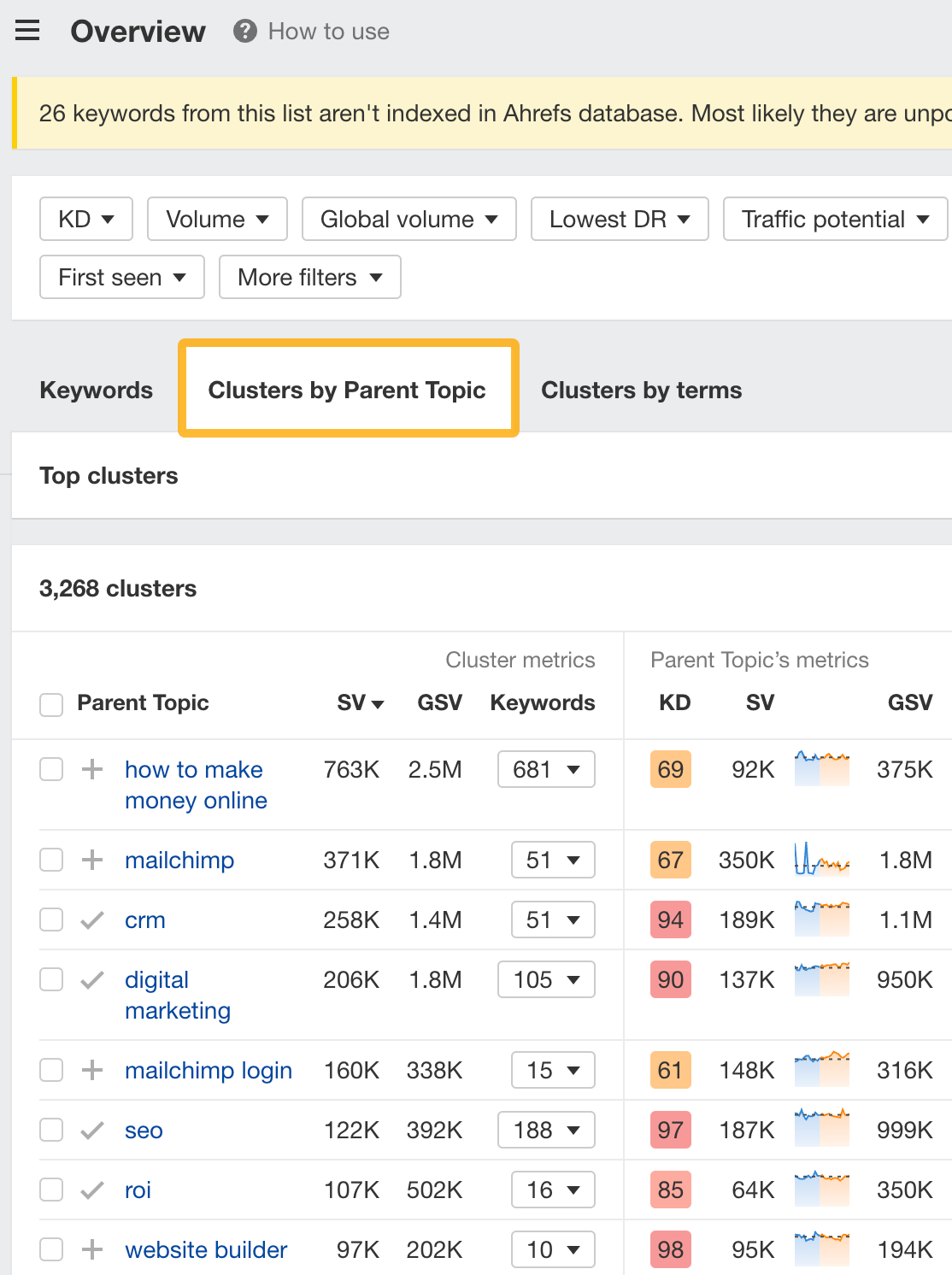

For example, MailChimp ranks for keywords like “what is digital marketing” and “digital marketing definition.” These and many others get clustered under the Parent Topic of “digital marketing” because people searching for them are all looking for the same thing: a definition of digital marketing. You only need to create one page to potentially rank for all these keywords.
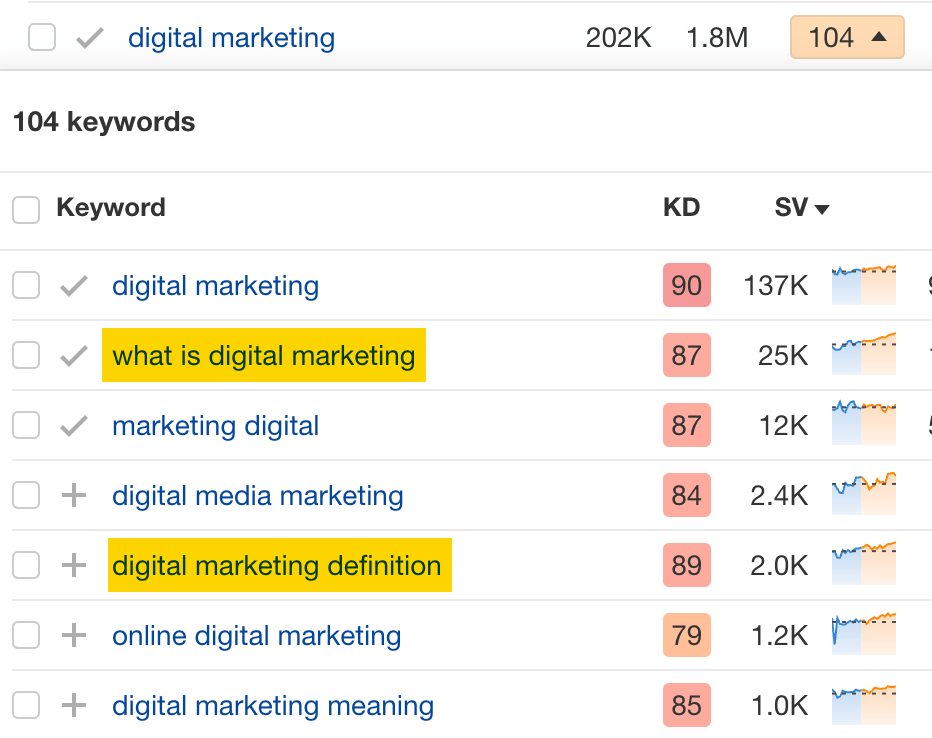

2. Optimize existing content by filling subtopics
You don’t always need to create new content to rank for competitors’ keywords. Sometimes, you can optimize the content you already have to rank for them.
How do you know which keywords you can do this for? Try this:
- Export your competitor’s keywords
- Paste them into Keywords Explorer
- Click the “Clusters by Parent Topic” tab
- Look for Parent Topics you already have content about
For example, if we analyze our competitor, we can see that seven keywords they rank for fall under the Parent Topic of “press release template.”


If we search our site, we see that we already have a page about this topic.


If we click the caret and check the keywords in the cluster, we see keywords like “press release example” and “press release format.”
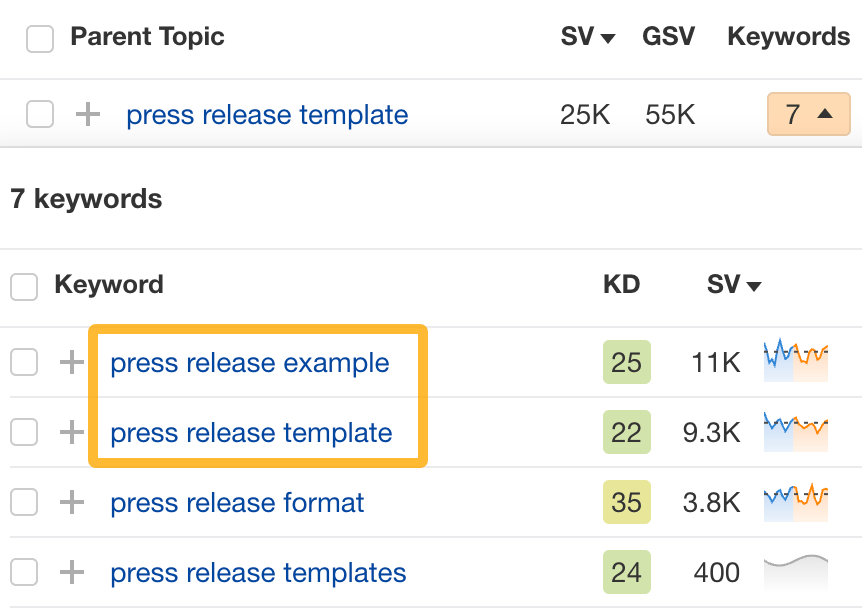

To rank for the keywords in the cluster, we can probably optimize the page we already have by adding sections about the subtopics of “press release examples” and “press release format.”
3. Target these keywords with Google Ads
Paid keywords are the simplest—look through the report and see if there are any relevant keywords you might want to target, too.
For example, Mailchimp is bidding for the keyword “how to create a newsletter.”


If you’re ConvertKit, you may also want to target this keyword since it’s relevant.
If you decide to target the same keyword via Google Ads, you can hover over the magnifying glass to see the ads your competitor is using.
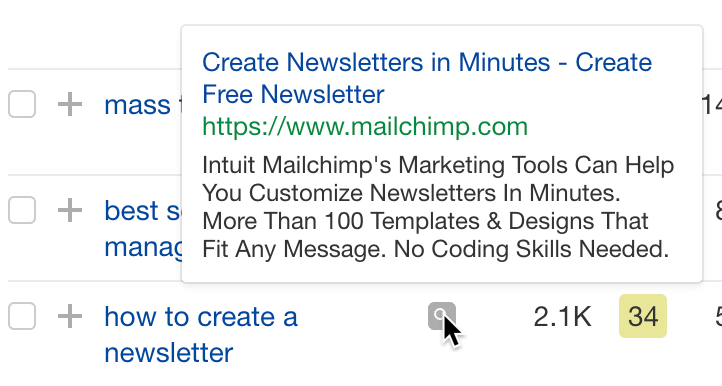

You can also see the landing page your competitor directs ad traffic to under the URL column.


Learn more
Check out more tutorials on how to do competitor keyword analysis:
SEO
Google Confirms Links Are Not That Important

Google’s Gary Illyes confirmed at a recent search marketing conference that Google needs very few links, adding to the growing body of evidence that publishers need to focus on other factors. Gary tweeted confirmation that he indeed say those words.
Background Of Links For Ranking
Links were discovered in the late 1990’s to be a good signal for search engines to use for validating how authoritative a website is and then Google discovered soon after that anchor text could be used to provide semantic signals about what a webpage was about.
One of the most important research papers was Authoritative Sources in a Hyperlinked Environment by Jon M. Kleinberg, published around 1998 (link to research paper at the end of the article). The main discovery of this research paper is that there is too many web pages and there was no objective way to filter search results for quality in order to rank web pages for a subjective idea of relevance.
The author of the research paper discovered that links could be used as an objective filter for authoritativeness.
Kleinberg wrote:
“To provide effective search methods under these conditions, one needs a way to filter, from among a huge collection of relevant pages, a small set of the most “authoritative” or ‘definitive’ ones.”
This is the most influential research paper on links because it kick-started more research on ways to use links beyond as an authority metric but as a subjective metric for relevance.
Objective is something factual. Subjective is something that’s closer to an opinion. The founders of Google discovered how to use the subjective opinions of the Internet as a relevance metric for what to rank in the search results.
What Larry Page and Sergey Brin discovered and shared in their research paper (The Anatomy of a Large-Scale Hypertextual Web Search Engine – link at end of this article) was that it was possible to harness the power of anchor text to determine the subjective opinion of relevance from actual humans. It was essentially crowdsourcing the opinions of millions of website expressed through the link structure between each webpage.
What Did Gary Illyes Say About Links In 2024?
At a recent search conference in Bulgaria, Google’s Gary Illyes made a comment about how Google doesn’t really need that many links and how Google has made links less important.
Patrick Stox tweeted about what he heard at the search conference:
” ‘We need very few links to rank pages… Over the years we’ve made links less important.’ @methode #serpconf2024″
Google’s Gary Illyes tweeted a confirmation of that statement:
“I shouldn’t have said that… I definitely shouldn’t have said that”
Why Links Matter Less
The initial state of anchor text when Google first used links for ranking purposes was absolutely non-spammy, which is why it was so useful. Hyperlinks were primarily used as a way to send traffic from one website to another website.
But by 2004 or 2005 Google was using statistical analysis to detect manipulated links, then around 2004 “powered-by” links in website footers stopped passing anchor text value, and by 2006 links close to the words “advertising” stopped passing link value, links from directories stopped passing ranking value and by 2012 Google deployed a massive link algorithm called Penguin that destroyed the rankings of likely millions of websites, many of which were using guest posting.
The link signal eventually became so bad that Google decided in 2019 to selectively use nofollow links for ranking purposes. Google’s Gary Illyes confirmed that the change to nofollow was made because of the link signal.
Google Explicitly Confirms That Links Matter Less
In 2023 Google’s Gary Illyes shared at a PubCon Austin that links were not even in the top 3 of ranking factors. Then in March 2024, coinciding with the March 2024 Core Algorithm Update, Google updated their spam policies documentation to downplay the importance of links for ranking purposes.
The documentation previously said:
“Google uses links as an important factor in determining the relevancy of web pages.”
The update to the documentation that mentioned links was updated to remove the word important.
Links are not just listed as just another factor:
“Google uses links as a factor in determining the relevancy of web pages.”
At the beginning of April Google’s John Mueller advised that there are more useful SEO activities to engage on than links.
Mueller explained:
“There are more important things for websites nowadays, and over-focusing on links will often result in you wasting your time doing things that don’t make your website better overall”
Finally, Gary Illyes explicitly said that Google needs very few links to rank webpages and confirmed it.
I shouldn’t have said that… I definitely shouldn’t have said that
— Gary 鯨理/경리 Illyes (so official, trust me) (@methode) April 19, 2024
Why Google Doesn’t Need Links
The reason why Google doesn’t need many links is likely because of the extent of AI and natural language undertanding that Google uses in their algorithms. Google must be highly confident in its algorithm to be able to explicitly say that they don’t need it.
Way back when Google implemented the nofollow into the algorithm there were many link builders who sold comment spam links who continued to lie that comment spam still worked. As someone who started link building at the very beginning of modern SEO (I was the moderator of the link building forum at the #1 SEO forum of that time), I can say with confidence that links have stopped playing much of a role in rankings beginning several years ago, which is why I stopped about five or six years ago.
Read the research papers
Authoritative Sources in a Hyperlinked Environment – Jon M. Kleinberg (PDF)
The Anatomy of a Large-Scale Hypertextual Web Search Engine
Featured Image by Shutterstock/RYO Alexandre
-

 PPC4 days ago
PPC4 days ago19 Best SEO Tools in 2024 (For Every Use Case)
-

 MARKETING7 days ago
MARKETING7 days agoWill Google Buy HubSpot? | Content Marketing Institute
-
SEARCHENGINES7 days ago
Daily Search Forum Recap: April 16, 2024
-

 SEO7 days ago
SEO7 days agoGoogle Clarifies Vacation Rental Structured Data
-

 MARKETING6 days ago
MARKETING6 days agoStreamlining Processes for Increased Efficiency and Results
-
SEARCHENGINES6 days ago
Daily Search Forum Recap: April 17, 2024
-

 PPC7 days ago
PPC7 days agoHow to Collect & Use Customer Data the Right (& Ethical) Way
-
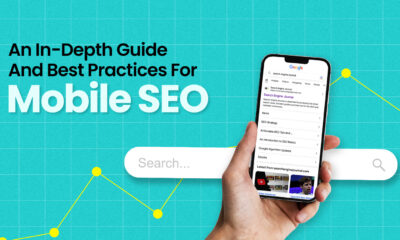
 SEO6 days ago
SEO6 days agoAn In-Depth Guide And Best Practices For Mobile SEO


